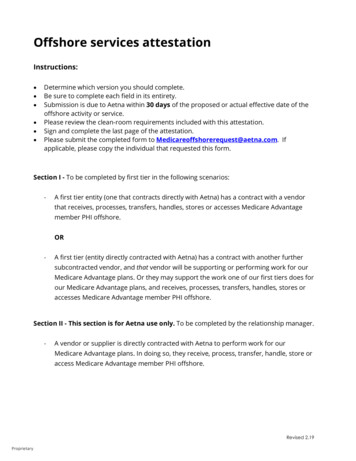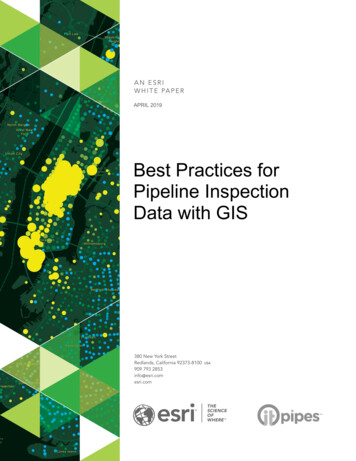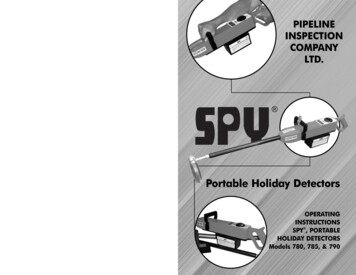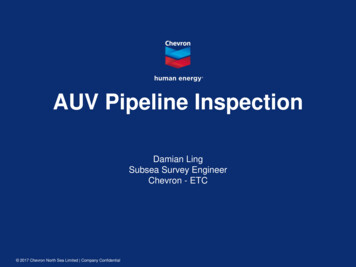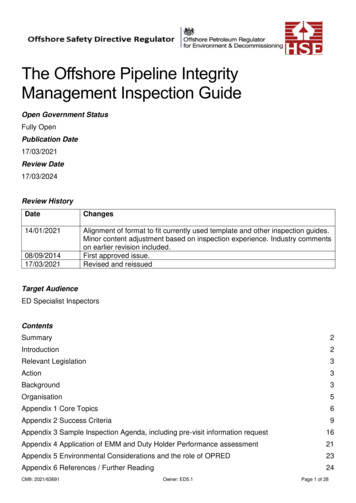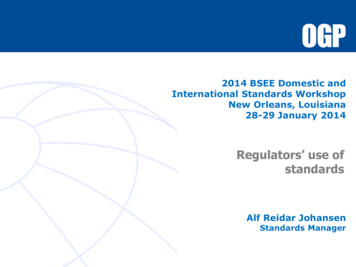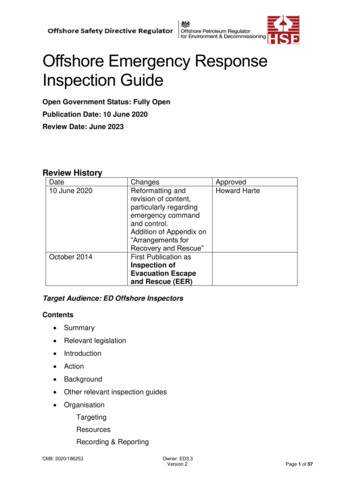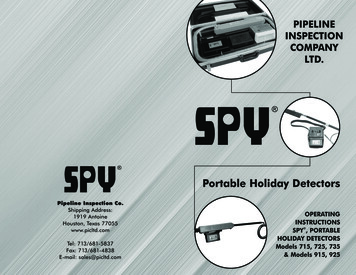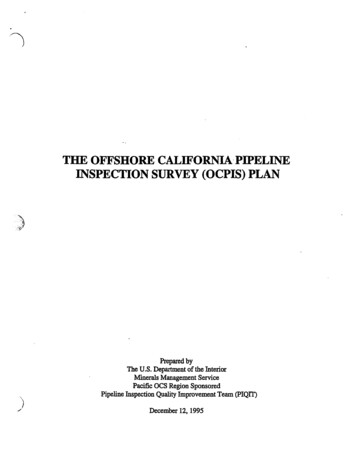
Transcription
THE OFFSHORE CALIFORNIA· PIPELINEINSPECTION SURVEY (OCPIS) PLANPrepared byThe U.S. Department of the InteriorMinerals Management ServicePacific OCS Region SponsoredPipeline Inspection Quality Improvement Team (PIQIT)December 12, 1995
Table of ContentsPageExecutive Summary. 1Introduction. 2The Offshore California Pipeline Inspection Survey (OCPIS) Plan . . . . . . . . . . . . . 3How the Process Works . . . . . . . . . . . . . . . . . . . . . . .·.- 4Inspection Criteria. . . . . . . . . . . . . . . . . . . . . . . . . . . . . . . . 6Pipeline Evaluation Workshop . . . . . . . . . . . . . . . . . . . . . . . . . . . . . . . . . . . . . . . . . . . . . . . 8Recommendations for MMS Management . . . . . . . . . . . . . . . . . . . . . . . . . 9Pipeline Inspection Quality Improvement Team . . . . . . . . . . . . . . . . . . . . . . . . . . . . . . . . . 11Acknowledgments. . . . . . . . . . . . . . . . . . . . . . . . . . . . 11AppendicesAppendix 1.Appendix 2.Appendix 3.Appendix 4.Appendix 5Overview of Regulatory Jurisdiction . . . . . . . . . . . . . . . . . 12Table of Post-Installation Inspection Requirements . . . . . . . 14MMS Pacific OCS Region Pipeline Inspection Requirements . . . . 17OCPIS Plan Decision Checklist . . . . . . . . . . . . . . . . . . . . . . . . . . . 19Map Showing Submerged Pipelines Related to Offshore Oil & GasProduction . . . . . . . . . . . . . . . . . . . . . . . . . . . . . . . . . . . . . . . . . . . . 21Appendix 6. Table of Federal, State and Local Agencies with InspectionRequirements on Offshore California Pipelines . . . . . . . . . . . . . . . 22Appendix 7. OCPIS Plan Contacts . . . . . . . . . . . . . . . . . . . . 32Appendix 8. Offshore California Pipeline Evaluation Checklist Part I: Data andInformation . . . . . . . . . . . . . . . . . . . . . . . 33Appendix 9. Offshore California Pipeline Evaluation Checklist Part Il: Analysisand Conclusions . . . . . . . . . . . . . . . . . . . . . . . . . . . . . . . . . . . . . . . 36Appendix 10. Offshore California Pipeline Evaluation Checklist Part Ill:Recommendations . . . . . . . . . . . . . . . . . . 37Appendix 11. Offshore California Pipeline Evaluation Checklist Parts I, II & Ill:Continuation Sheet . . . . . . . . . . . . . . . . . . . . . . . . 38Appendix 12. Glossary . . . . . . . . . . . . . . . . . . . . . . . . . . . . . . 39)FiguresFigure 1Offshore California Pipeline Inspection Survey Plan . . . . 5
) ,.Executive SummaryThe Offshore California Pipeline Inspection Survey (OCPIS) Plan was developed by a multi agency team composed of representatives from the Minerals Management Service (MMS),Department of Transportation (DOT), California State Lands Commission (CSLC), California StateFire Marshal (CSFM) and the Division of Oil, Gas, and Geothermal Resources (DOGGR). TheOCPIS Plan is intended to provide user agencies with an analytical framework for assessing thepresent condition and inspection needs of offshore pipelines as a necessary precursor to makinginformed decisions on the feasibility of operator's inspection plans, waiver requests and other relatedissues.One of the key elements of the OCPIS Plan is the emphasis placed on coordination betweenagencies that have regulatocy jurisdiction over offshore pipelines. The OCPIS Plan underscores theimportance ofcoordination between agencies early in the process to identify issues and concerns anddevelop consensus on regulatory actions.An integral part of the OCPIS Plan process is a detailed evaluation of the pipeline, its risk potentialfrom accidents or failures and the operator's regulatory compliance history. At the cornerstone ofthe pipeline evaluation are 36 inspection criteria which influence the conduct and timing of internaland external pipeline inspections. The relative influence of each criterion on a particular surveystrategy is subjectively determined and variable from line to line and setting to setting.The OCPIS Plan is designed to: (1) provide regulators with a reasonable assessment of theinspection needs for individual pipelines; (2) permit operators to develop innovative inspectionstrategies that are tailored to the needs of individual lines based on established operational andenvironmental criteria unique to each; (3) improve the safety of offshore pipelines and reduce therisk of failure by requiring operators to conduct the most beneficial surveys based on thecondition of the line; and (4) afford industry an opportunity to reduce survey costs as a benefit ofdiligent and innovative inspection and maintenance.actualThe OCPIS Plan was tested and refined during a simulated evaluation of Unocal's Dos Cuadraspipelines and the operator's request for a waiver ofMMS inspection requirements (on the gas lines).The exercise indicated that the process and procedures worked well for assessing the inspectionneeds of pipelines and evaluating the operator's waiver request. The process is sufficientlycomprehensive and flexible to be useful when considering each of the action items for which it wasdesigned.Nine recommendations are offered which could enhance the effectiveness of the :MMS pipelineinspection program including implementation of the OCPIS Plan in concert with other affectedagencies. Although a uniform pipeline inspection plan is not proposed or considered necessary, thecurrent lv.lM:S inspection plan for POCS facilities, with certain refmements, is a comprehensivemodel for pipelines in both federal and state waters.1
'J1"IntroductionThe Minerals Management Service (MMS), in reviewing recent offshore pipeline inspection surveys,recognized the need for refinements which would benefit both government and industry. Realizingthat other federal, state and local agencies have different inspection requirements on the samepipelines, the MMS invited interested agencies to participate in a technical workgroup to reviewexisting federal and state agency requirements for external inspections for pipelines on the PacificOuter Continental Shelf (POCS) and to develop guidelines to improve the quality of such surveys.The Pipeline Inspection Quality Improvement Team (PIQIT) convened in the Spring of 1994,as a multi-agency committee consisting of the S, Department of Transportation (DOT),California State Lands Commission (CSLC), California State Fire Marshal (CSFM) and the Divisionof Oil, Gas, and Geothermal Resources (DOGGR). By consensus of the participating agencies, theworkgroup's charter was broadened to include pipelines in state waters and a review of internalinspection survey requirements.BackgroundOver the years, various federal, state and local agencies have imposed internal and externalinspection requirements on offshore pipelines in accordance with the4" respective jurisdictionalauthorities, responsibilities and interests (see Appendix 1). Due to the lack of uniformity in agencyregulations and requirements, industry is often faced with redundant and sometimes contradictory·inspection requirements. As a result, offshore pipeline operators are often required to performinternal and external inspections on pipelines at fixed intervals regardless of the pipeline conditionor the need for inspection.·The PIQIT's Inspection PhilosOl')byAt the outset, some participating agencies voiced an interest in standardizing as much as possibleinspection requirements for offshore lines which at present vary considerably from agency to agency(see Appendix 2). In particular, differing frequency requirements for some surveys are a source ofconcern for some pipeline operators who desire more uniformity in agency inspection requirementsand inspection intervals that are determined by the actual condition of the line.After e,ramining in great detail the many variables (see Inspection Criteria) which influence surveymethodology and frequency, the team decided to develop a standardized process for evaluatingpipeline inspection plans and industry requests to waive existing pipeline inspection requirementsin lieu of a uniform inspection plan. Factors which influenced this decision are indicated below.(1) Some agencies do not have the regulatory authority to mandate routine surveys exceptin response to a specific incident.(2) The principle factors ("primary criteria") influencing surveys tend to be line specific anddo not conform well to prescriptive inspection requirements.2
(3) The team is unaware of any scientific or engineering data to support an inspectionfrequency that is more valid than the one and two year intervals currently established byvarious agencies for internal and external surveys.(4) A uniform inspection policy will not mitigate all operator's concerns regarding currentMMS pipeline inspection requirements which have generated numerous requests forwaivers and may continue to generate waiver requests in the future.(5) The uniform process we are advocating eliminates the need for uniform regulations andattendant statutory revisions that might be required for implementation by some agencies.Given the limited number of offshore oil, gas and water pipelines currently in operation (78) oranticipated in the future, the PIQIT has concluded that the best approach to inspectin offshorepipelines is to critically examine each line individually and develop an inspection schedule for eachbased on the present condition and risk potential of the line, When this is not possible, MMS'existing policy and requirements (see Appendix 3), with certain refinements (see Recommendation#4), is an adequate default plan for POCS lines and a fairly comprehensive model for other agenciesdesiring a more uniform inspection plan.The Offshore California Pipeline Inspection Survey (OCPIS) PlanThe OCPIS Plan is a consensus-based, decision-making process which is intended to provide useragencies with an analytical framework for assessing the present condition and inspection needs ofsubmerged offshore pipelines associated with oil and gas production.An integral part of the OCPIS Plan process is an evaluation of the pipeline's integrity, inspectionand maintenance histories, risk potential for accidents or failures and the operator's regulatorycompliance history. This detailed evaluation should:(1) provide regulators with a reasonable assessment of the current condition and inspectionneeds for individual lines (or systems);(2) permit operators to develop inspection schedules that are tailored to the needs ofindividual lines (or systems) based on the demonstrated operational andenvironmental considerations (criteria) specific to each;(3) improve pipeline safety and reduce the risk of failure by requiring the operator to conductthe most beneficial surveys based on the actual condition of the line; and(4) reduce operator's survey costs as a benefit of diligent and innovative inspection andmaintenance.3
The OCPIS Plan process and procedures (described below and detailed in checklists in theAppendices) is a sequential nine-step process which is intended to:- identify agencies' issues and concerns,- focus deliberations to resolve concerns,- develop a partnership between agencies to exchange information and resolve differencesthrough coordination and negotiation with operators,- develop alternative inspection or remediation proposals as needed,- build consensus among agencies and- make appropriate recommendations.The flow-chart process and checklist procedures have been presented in a structured format that iscomprehensive, user-friendly and safficiently flexible to be easily amended as time and experiencedictate. Although the procedures were validated and fine-tuned in a simulated exercise (see PipelineEvaluation Workshop), in actual practice, certain steps or procedures may be stressed or omittedas the situation warrants. For example, the user may not need to work through all of the steps andchecklist procedures to achieve an appropriate and timely (consensus) response to an offshoreincident that are necessary for evaluating an operator's waiver request or plan submittal. We areconfident the OCPIS Plan will provide users with comprehensive and flexible guidelines that willhelp to focus and simplify their deliberations without needlessly exacerbating the process.How the Process WorksThe OCPIS Plan flow chart (Figure 1) and decision checklist (Appendix 4) are to be utilized whenconsidering each of the following proposed actions:(1) An operator's survey plan or request for a waiver from existing survey requirements;(2) An agency's request for a change in current survey requirements; or(3) An agency's requirement for an unscheduled inspection following an offshore incidentor accident.Once an action is initiated, either by an agency or an operator, a lead agency is identified. In general,the lead agency(ies) for OCPIS Plan actions will usually be one of the following:(1) The .MMS for lines originating at a platform in federal waters or for an incidentoccurring in federal waters;(2) The CSLC, DOGGR or CSFM (to be determined) for lines located entirely within statewaters or for an incident occurring in state waters; or(3) The agency initiating the action or whose requirements motivated the action.4
Offshore Callfomla Plpellne Inspection Survey Plan(Figure 1)Operator submits survey plan or requesls waiver from exlsttfng survey requlramentsAgency requesas aChange In cunent survey planlncfdent occurs which requires an lnspeetlan(Step 1)(Step2)YaNo(Step 3)lnfonn AgenciesObtain Missinglnfannatfon(Step 4)YaEvaluate Plpellne(Checkllst II)(Step 5)No(Step&)(Step 7)Address ConcernsThmugh CoOldlnatlonwith Agencies &/orOperator(Step 8)(Step 9)jAction Approved orDeniedSend Letter toOperator)5
For example, using Torch Operating Company's Pt. Pedernales Pipeline ·(from Platform Irene toshore):- if the operator submits a survey plan to the MMS for approval, 1vlMS will assume the lead;- if the operator submits a request for a waiver of a DOT requirement, the DOT will assumethe lead;- if an incident occurs ; n the state waters portion of the line, the CSLC or CSFM willassume the lead; or- if1vlMS requests a revision to the operator's cU1Tent inspection plan, 1vlMS will assume thelead.The lead agency will examine the jurisdictional issues and gulatory requirements of each affectedfederal, state and local agency and detexmine if a joint review or consultation is needed (see locationmap and tables presented in Appendices 5 and 6). If coordination is necessary, the lead agency willinform all affected agencies of the pending action (see list of contacts provided in Appendix 7).The lead agency will then initiate an evaluation of the pipeline or system utilizing the proceduresidentified in the "Offshore California Pipeline Evaluation Checklist Parts I and II" (Appendices 8,9,and 11). The lead agency gathers pertinent design, operational, inspection, repair, environmental andother data and information from agencies' and operator's files (Checklist Part I). This informationis synthesized by the lead agency to assess the present condition of the line, the compliance historyof the operator and the potential for future pipeline failures (Checklist Part II).The lead agency discusses the pipeline evaluation with the affected agencies and initiates anevaluation of the proposed action either independently or jointly with the affected agencies, asappropriate, using the "Offshore California Pipeline Evaluation Checklist Part Ill" as a guide(Appendices 10 and 11). The agencies identify and attempt to resolve concerns relating to thepipeline evaluation, the proposed action or an alternative recommended action(s) throughcoordination and negotiation with all parties including the operator. The agencies work towardsachieving a consensus decision on the proposed action, if possible, and issue either joint orindependent recommendations to their respective managements to approve or deny the proposedaction (i.e, plan or waiver request) or to require an alternate inspection or remediation plan asappropriate. The operator is subsequently notified in writing of the agency's(ies') decision(s).Inspection CriteriaAn integral part of the OCPIS Plan process is the pipeline evaluation which is based on an analysisof eight general categories of information (containing 36 influential criteria) related to pipelinedesign, operation, inspection, maintenance, incident history, physical environment and other factors.Other criteria (e.g., pipeline age) were considered and omitted from the list if they were determinedto exert little or no influence on the development or evaluation of a survey plan or waiver requestfor either internal or external surveys (see Glossary definition for 11criteria/non-applicable"). The36 influential criteria are compiled on Checklist Part I (Appendix 8) and synthesized and evaluated6
on Checklist Part 1I (Appendix 9). Definitions for various criteria and·related terminology areprovided in the Glossary (Appendix 12).Individual criteria on Checklist Part I are relatively weighted as "primacy", "secondary" or "non applicable" depending on how much weight (or influence) should be placed on the factor in assessinginternal and external survey methods and frequencies. The purpose of defining and weightingcriteria was to provide an analytical basis for evaluating the integrity and inspection needs ofoffshore pipelines to assist in regulatory decision-making. However, the weight a user places on anindividual criterion may be entirely subjective and in many cases line and setting dependent. Theuser must decide how much weight to place on a given criterion for a given situation or environmentin reaching a decision."Primary criteria" are defmed in the Glossary as "key factors which are considered in determiningwhat, where, when and how surveys should be conducted. . 11 The key factors which tend toinfluence the character, quality and timing of internal inspections include: pipe design criteria (e.g.,diameter, wall thickness, steel grade), operating conditions (pressures, flow rate, product type andcomposition), pipeline characteristics (e.g., internal corrosion and corrosion controls, externalcathodic protection type) internal inspection and maintenance histories and other factors (i.e.,whether the line can be smart pigged). In contrast, with the exception of pipeline maintenancecriteria and cathodic protection, the key factors influencing external inspections are markedlydifferent from the above and equally diverse and include: external pipeline characteristics (e.g., typeof cathodic protection, pipe coating, exposures and spans), proximity to biologically sensitive areas(e.g., hard bottoms), external inspection and maintenance histories, external corrosion and corrosioncontrols and offshore incidents (seismic/storm loads, third party damage)."Secondary criteria" (e.g., most environmental factors) are defined as "factors which may alter oramend an existing survey strategy but are usually not crucial to the initial development or evaluationof the plan." Secondary factors may become more influential decision-making tools under certaincircumstances over the operational life of the pipeline.What should be apparent from a cursory examination of the criteria listed on Checklist Part I is thatthe factors influencing internal and external inspections are numerous, diverse and, in most cases,line specific. With increased time and experience doing pipeline evaluations, it may be possible toidentify one or two key indicator criteria which can be used as reliable yardsticks to streamline theprocess. "Age" is a criterion that is often used as an indicator of pipeline integrity for the purposeof predicting inspection needs. In actuality, it is not the age of the line that is the significantparameter but other design or operational characteristics (i.e., corrosion, rate of corrosion, ineffectivecoITOsion controls, steel grade, wall thickness, etc.) which are the underlying causes of metal fatigueand pipe failures in offshore pipelines. For the present, we believe that the most conservativeapproach which will provide the desired margin of safety to the public and a long-term cost-benefitto industry is the detailed evaluation we are proposing using the 36 influential criteria as a guideline.)7
Pipeline Evaluation WorkshopThe PIQIT convened a workshop in July and August, 1995, to validate and refine the OCPIS Planprocess and procedures. During the four day exercise, workshop participants assessed the adequacyand utility of the OCPIS Plan by evaluating Unocal's request for a waiver of :MMS pipelineinspection requirements issued in September, 1990, for the operator's Dos Cuadras interconnectinggas pipelines operating between Platforms B to A and Platform A to shore.As part of the exercise, participants made a detailed evaluation of the integrity of the lines using thedraft process and checklists as a guide. The team initially gathered pertinent engineering design,inspection and maintenance data and information on the lines from agency files and requested andreceived additional information from the operator. The team completed and evaluated Checklist PartL During this phase of the exercise, the team determined that additional critical data and informationgermaine to the inspection, maintenance and risk assessment of the Dos Cuadras gas lines wasneeded. The exercise was temporarily haulted pending receipt of the information which werequested from the operator. The team utilized all the information and conducted an evaluation ofthe integrity of the gas lines and completed and evaluated Checklist Part IL Subsequently, the teamexamined the operator's waiver request and recommendations to restructure Checklist Part m.The OCPIS Plan process (flow chart) and procedures (checklists) were validated and amendedduring the exercise. ·The exercise verified the comprehensiveness of the checklists in identifyingsignificant data and information gaps which needed to be addressed during the pipeline evaluationprocess. The operator was very helpful in providing the PIQIT with the data and informationrequested which greatly enhanced the value of the workshop.The exercise demonstrated the usefulness of the team's concept in evaluating the integrity ofoffshorepipelines and illustrated some areas that needed refinement. The exercise also indicated that thedraft process and procedures worked well for evaluating the operator's waiver request even thoughthe team did not attempt to reach consensus on the proposed action, as that would have requiredconsultation with the operator which was beyond the purpose and scope of the exercise.By the close of the workshop, all participants were comfortable that the OCPIS Plan will provideagencies with a common set of evaluation criteria and a structured, consensus-building process withwhich to make informed decisions on a variety of technical issues related to pipeline inspection andmaintenance. The team is confident that we are offering management a tested process that issufficiently comprehensive and flexible to be useful when considering each of the action itemsidentified on the flow chart.iJ8
Recommendations for MMS ManagementThe following recommendations (1-3) focus on the OCPIS Plan process which is the primaryproduct the team would like management to adopt. The remaioin3 recommendations (4-9), webelieve, if adopted, would further enhance the effectiveness of the :MMS POCS Region's pipelineinspection program.1. Implement the OCPIS Plan process and procedures. A S should review annually and reviseas needed.2. Develop an MOU with OCPIS Plan agencies to implement jointly Recommendation #1.3. Issue waivers to inspection requirements only to operators who have demonstrated a satisfactoryhistory of compliance and whose lines are adequately inspected and maintained.4. Restate POCSR pipeline inspection policy and revise current inspection requirements (issued inSeptember, 1990) stressing an inspection philosophy that:(a) is flexible, cost-effective and possibly risk-based (see item 8),(b) affords maximum safety and does not compromise on the ha]]marlc of zero-tolerancefor pollution,(c) recognizes the uniqueness and small number of POCS pipelines, the politicalsensitivity ofpipelines and pollution and that most pollution from pipelines is the resultof third party damage, not line failures,(d) requires an initial baseline survey that is repeated in two years,(e) states a default policy with a minimum frequency (e.g., internal and external surveysconducted at least once a year or every two years; annual cathodic protection surveys;use of pressure tests if lines are not smart piggable),(t) illustrates the compatibility, utility and need for various inspection tools andtechniques.5. Update and fina1izP, external pipeline survey requirements using side scan sonar.6. Develop guidelines for external visual/cathodic protection surveys using remote operatedvehicles (ROV).7. Develop :MMS POCSR NTL on pipeline inspections.9
,'),,,8. Review MMS Gulf of Mexico Region proposed risk-based pipeline inspection program andconsider if a similar program should be adopted in POCSR given the political climate andconstraints (i.e., zero-tolerance for pollution).9. Examine procedures to reduce the risk of third-party damage (e.g., one-call system, improvedpipeline location maps/charts).
Pipeline Inspection Quality Improvement TeamRICHARD CLINGAN, Team Leader, Minerals Management Service, Santa Maria CaliforniaTHERESA BELL, Minerals Management Service, Camarillo, CaliforniaSTEVE FIELDS, Division of Oil, Gas, and Geothermal Resources, Ven CaliforniaROBERT GORHAM, California State Fae Marshal, West Covina, CaliforniaJIM HART, California State Lands Commission, Long Beach, CaliforniaJOHN McCARTHY, Minerals Management Service, Camarillo, CaliforniaMICHAEL MITCHELL, Minerals Management Service, Santa Maria, CaliforniaLBSLIB MONAHAN, Minerals Management Service, New Orleans, LouisianaGREG PELKA, California State Lands Commission, Long Beach, CaliforniaJOHN SMITH, Minerals M ement Service, Camarillo, CaliforniaCATHERINE STANEK, Minerals Management Service, Camarillo, CaliforniaAcknowledgmentsMany people contributed to the successful outcome of this project. In particular, the team would liketo thank those individuals who contributed in our meetings and workshop and to this report:NABIL MASRI, Team Sponsor, Minerals Management Service, Camarillo, CaliforniaQUANG BACH, California State Lands Commission, Long Beach, CaliforniaCHANDRA BASAVALINGANADODDI, California State Lands Commission, Long Beach,CaliforniaKEVIN DRUDE, County of Santa Barbara, Energy Division, Santa Barbara, CaliforniawaLIAM DUGAN, Unocal, Ventura, CaliforniaVINCENT ECCLESTON, Chevron Pipeline Company, Bakersfield, CaliforniaLUIS ESPINOSA, British Gas Inspection Services, Inc., Houston, TexasDAVID GEBAUER, Minerals Management Service, Camarillo, CaliforniaJAMES GRANT, Minerals Management Service, Camarillo, CaliforniaBRUCE IDGGINS, Minerals Management Service, Camarillo, CaliforniaPAUL KARLOZIAN, Karlan Corporation, Glendale, CaliforniaPETER KATCHI\'1AR, U.S. Department of Transportation, Office of Pipeline Safety, Lakewood,ColoradoHOSFEJN MONFARBD, California State Fire Marshal, West Covina, CaliforniaAIDEN NAUGHTON, California State Lands Commission, Long Beach,. CaliforniaFARJBA NEESE, Division of Oil, Gas, and Geothermal Resources, Ventura, CaliforniaNOLLIE Gll.DOW-OWENS, Minerals Management Service, Camarillo, CaliforniaCHARLES SAMO, California State Fire Marshal, West Covina, CaliforniaROBIN VILLA, Fugro West, Ventura, Californiaj)11
Appendix 1. Overview of Regulatory JurisdictionSafety regulation of marine pipelines is shared by the following federal and state agencies offshoreCalifornia:u,s. Pq,artment of the Interior, Minerals Management ServiceThe Minerals Management Service (MMS) currently has shared jurisdiction with the Departmentof Transportation (DOT) for regulating oil and gas pipelines on the Pacific Outer Continental Shelf(POCS). MlVIS authority is granted under the Outer Continental ShelfLarids Act of 1978 (43 U.S.C.1334). Regulations exclusive to DOI pipelines are contained in 30 CPR Part 250, Subpart J. Underthe existing 1976 Memorandum ofUnderstanding (MOU) with DOT, DOIpipelines are all pipelinesupstream, from the outlet flange at each facility where hydrocarbons are produced, or where producedhydrocarbons are first separated, dehydrated, or otheiwise processed to each production well on theOCS. In addition, those pipelines necessary for the development of a lease (e.g. gas-lift gas or supplypipelines), are under oars exclusive control. 1Under OCSLA, the :MM:S issues either lease term permits or rights-of-way approvals for all OCSpipelines. The agency may prescribe, as conditions to these permits and approvals, stipulationsnecessary to protect human, marine and coastal environments, life, property and mineral resources.In pursuit of its goal of "maximum environmental protection", the agency has applied its inspectionrequirements (pursuant to 30 CFR 250.161 (e)(l) and 250.155) to all DOT regulated pipelines onthe POCS and lines extending from facilities in federal waters into state waters. The JvIMS issuedinspection requirements to POCS pipeline operators in September 1990 (see Appendix 3).The Oil Pollution Act of 1990 (OPA 1990), as implemented by Presidential Executive Order 12777(October, 1991), expanded MMS responsibility for pollution prevention associated with marinepipelines. The OPA gave the MMS regulatory responsibility for ensuring spill prevention andresponse capability for all offshore pipelines including those in state waters.U.S. Department of Transportation, Office of P
pipeline inspection plans and industry requests to waive existing pipeline inspection requirements in lieu of a uniform inspection plan. Factors which influenced . this . decision are indicated below. (1) Some agencies do not have the regulatory authority to mandate routine surveys except . in . response to a specific incident.


